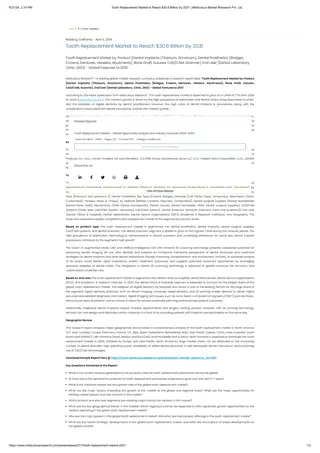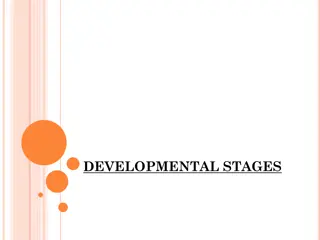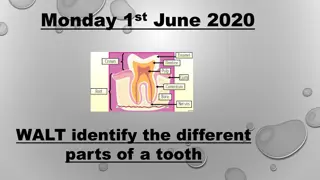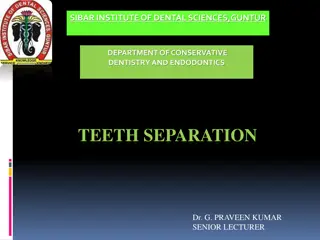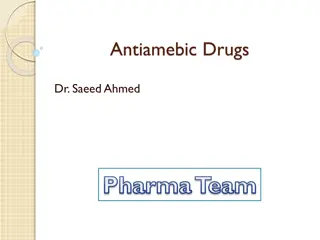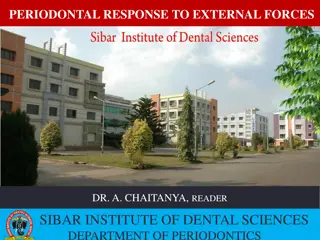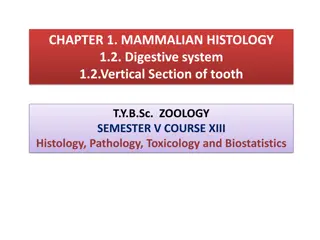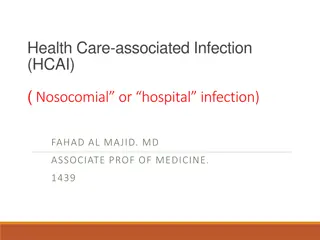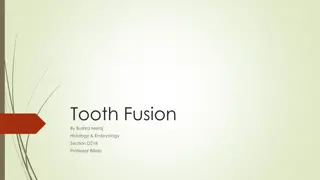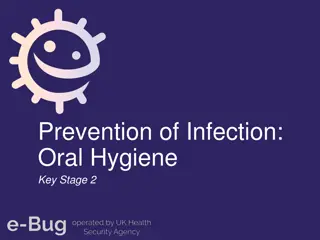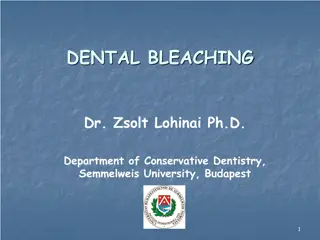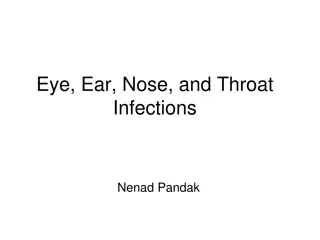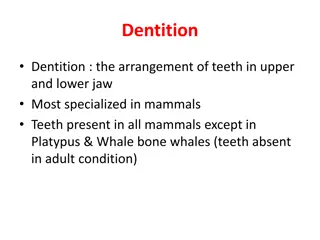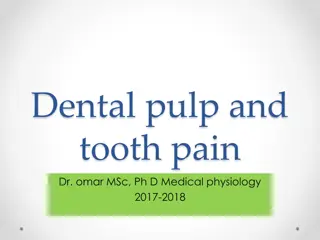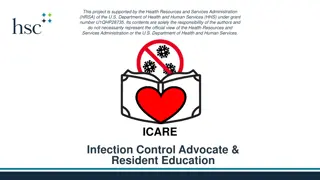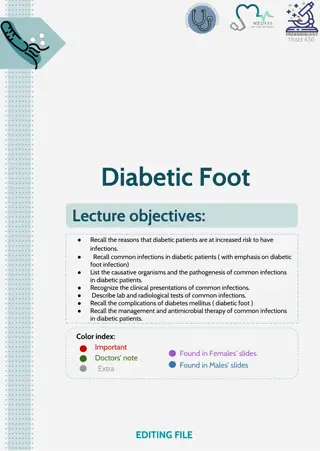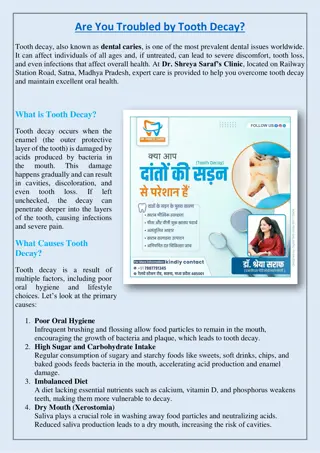Understanding Anaemia and Infections in Relation to Health
Anaemia can result from various causes such as blood loss, increased destruction of red blood cells, and impaired production, often linked to infections and chronic diseases. Parasites, bacteria, and viruses play a role in the progression of anaemia, affecting the body's ability to produce and utili
3 views • 10 slides
Understanding Nontuberculous Mycobacteria Infections in Cystic Fibrosis
Nontuberculous mycobacteria (NTM) infections present a significant challenge in individuals with cystic fibrosis (CF). These infections are caused by over 200 species of atypical mycobacteria found in various environments. The CF-ID Clinic plays a crucial role in managing patients with multi-drug re
2 views • 25 slides
Understanding the Development of Occlusion and Dentition
Exploring the stages of tooth development, eruption, theories, and keys to normal occlusion. Learn about primary and permanent dentition, dental formulae, dental lamina, odontogenic cells, and enamel organ formation in the process of tooth development.
6 views • 108 slides
DEVELOPMENTAL STAGES
The developmental history of a tooth is segmented into distinct stages, namely the bud, cap, and bell stages. Each stage represents critical morphological changes in tooth development, from the initial formation of tooth buds to the differentiation of enamel organs and dental papilla. Understanding
6 views • 33 slides
Emergency Dentist Donvale
When a tooth-ache develops, there are very few things that will settle it. Over the counter analgesic medications can dull the pain for a short period of time but it won\u2019t alleviate the pain completely nor will it solve the underlying problems. When a tooth pulp\/ nerve becomes inflamed due to
2 views • 7 slides
Emergency Tooth Extraction Services in NJ
Get relief with NJ emergency tooth extraction treatments from Lunadentalnj.com. Put your trust in our caring staff to handle any dental emergency.\n\n\/\/lunadentalnj.com\/services\/
4 views • 1 slides
Best Wisdom Tooth Surgery in Boon Keng
Absolute Family Dental serves the Best Wisdom Tooth Surgery in Boon Keng. They listen to you, and their aim to provide ethical and caring dental services for every patient at affordable prices. Every patient will be treated with the utmost privacy and assured of the highest standard of cross-infecti
2 views • 6 slides
Anaerobic Bacterial Infections: Overview and Clinical Implications
Anaerobic bacterial infections are caused by bacteria that do not require oxygen for growth, posing challenges in diagnosis and treatment. This article delves into the types of anaerobic bacteria, their role in human infections, and common clinical presentations such as abscess formation. Gram-negat
2 views • 24 slides
Tooth Replacement Market Trend to Reach $30.6 Billion by 2031
The adoption of digital technologies in dentistry, such as X-rays, intraoral scanners, digital impressions, and CAD\/CAM, among others, has led to improved accuracy and efficiency in diagnosis, improved treatment planning, reduction of human error, and personalized treatment solutions. Due to improv
0 views • 2 slides
Dental Developmental Stages: Bud, Cap, and Bell Stages Explained
The developmental history of a tooth is intriguingly divided into distinct morphologic stages - the bud, cap, and bell stages. Each stage represents a crucial phase in tooth development, from the initial formation of tooth buds to the intricate differentiation of enamel organs and dental papilla. Un
1 views • 40 slides
Understanding the Different Parts of a Tooth
Explore the structure of a tooth by learning about its various parts such as enamel, dentine, pulp, and more. Discover the difference between the crown and root, and engage in interactive activities like labeling diagrams and creating models to enhance your understanding. Watch a video for a detaile
0 views • 7 slides
Understanding the Role of Alveolar Process in Dental Development
The alveolar process in the upper and lower jaw plays a vital role in housing, supporting, and protecting teeth. It anchors tooth roots, facilitates tooth movement for proper occlusion, absorbs and distributes occlusal forces, supplies vessels to the periodontal ligament, and aids in tooth eruption.
1 views • 28 slides
Understanding Fungi Diversity and Infections in Microbiology
Explore the world of fungi and fungal infections in this foundation block of microbiology. Learn about medically important yeasts, mold fungi, major fungal diseases, antifungal agents, and infection acquisition methods. Dive into hypersensitivity reactions, mycotoxicoses, and various types of fungal
1 views • 19 slides
Tooth Separation in Conservative Dentistry and Endodontics: Methods and Importance
Tooth separation is essential in restorative procedures to enhance convenience, achieve proper contacts and contours, improve operative treatment outcomes, and maintain oral health. This process involves slightly moving teeth apart or closer, or changing their spatial position. Different methods suc
1 views • 28 slides
Structure and Functions of the Alveolar Process in Jaw Anatomy
The alveolar process in the upper and lower jaw is responsible for housing the roots of teeth, supporting tooth eruption, providing attachment for facial muscles, and aiding in mastication. During fetal development, the alveolar process forms and separates tooth germs, leading to the differentiation
3 views • 26 slides
Understanding Virus-Cell Interactions and Infections
Viral infections exhibit diverse cellular tropism based on receptor interactions, impacting cell function through modulation and potential host defense responses. Infections can lead to various outcomes, from cell death to persistent or latent states, with nuanced effects on cellular behavior. Diffe
0 views • 8 slides
Understanding Antiamebic Drugs: A Guide to Managing Protozoal Infections
Protozoal infections, such as amebiasis, are a significant concern globally. In underdeveloped regions and beyond, these infections pose challenges due to inadequate sanitation and hygiene practices. Antiamebic drugs are essential for treating conditions like amebiasis, caused by Entamoeba histolyti
0 views • 40 slides
Understanding Veneers and Laminates in Dentistry
Patients are increasingly seeking aesthetic treatments for anterior teeth, leading to the popularity of veneers and laminates. Veneers are tooth-colored layers applied to restore defects and discoloration, offering a less invasive and durable alternative to full crowns. The process involves applying
4 views • 55 slides
Understanding the Role of Alveolar Process in Dental Support
The alveolar process in the upper and lower jaw plays a crucial role in supporting teeth, anchoring them to the alveoli with Sharpey's fibers. It helps in tooth movement for proper occlusion, absorbs and distributes occlusal forces, supplies vessels to the periodontal ligament, and protects both pri
2 views • 42 slides
Understanding Anthelmintics: Drug Therapy for Parasitic Worm Infections in Veterinary Medicine
Anthelmintics are essential drugs to combat parasitic worm infections in animals. They work either by killing (vermicide) or expelling (vermifuge) the worms, reducing worm burdens and controlling infections. This comprehensive overview covers different aspects of anthelmintics, including their prope
2 views • 34 slides
Periodontal Response to External Forces in Periodontics
Adaptive capacity of the periodontium in response to occlusal forces is variable, influenced by factors like magnitude, direction, duration, and frequency. Trauma from occlusion occurs when occlusal forces exceed tissue's adaptive capacity, leading to tissue injury. It is classified into acute and c
0 views • 40 slides
Understanding the Treatment of Respiratory Tract Infections: Antibiotics and Management
This lecture covers the classification of respiratory tract infections and the antibiotics commonly used to treat them. It highlights the types of infections caused by viruses and bacteria, along with their respective treatments. The mechanism of action and pharmacokinetics of antibiotics, such as p
0 views • 7 slides
Best Wisdom tooth surgery in Orchard
If you\u2019re looking for Wisdom tooth surgery in Orchard, contact Singapore Dental Implant Centre. They offer comprehensive services from all fields of dentistry. From dental implants and wisdom tooth surgery to root canal treatments and dental cro
0 views • 6 slides
Mammalian Tooth Structure: Vertical Section Overview
Mammalian teeth consist of hard tissues (enamel, dentine, cementum) and soft tissue (tooth pulp). The enamel is the hardest, dentine surrounds the pulp cavity, and cementum covers the dentine and connects to the alveolar bone. Tooth pulp provides support, nourishment, and defense mechanisms. Support
1 views • 7 slides
Understanding Health Care-associated Infections (HCAI) in Hospital Settings
Health care-associated infections (HCAI), also known as nosocomial or hospital infections, are infections that occur in patients during their hospital stay or after discharge. These infections can result from various sources, including colonization by microorganisms and exposure to contaminated envi
0 views • 48 slides
Understanding Tooth Fusion in Dentistry
Tooth fusion is the merging of two tooth germs into a single large crown, which can be complete or incomplete depending on the developmental stage. It can affect primary dentition, mostly incisors and canines. Differentiating fusion from gemination involves examining the pulp chambers. Causes may in
0 views • 9 slides
Importance of Oral Hygiene and Preventing Tooth Decay in Children
Understanding the significance of oral hygiene and preventing tooth decay in children is crucial for their overall health. By learning about dental plaque, causes of tooth decay, effective teeth brushing techniques, and the impact of sugary foods and drinks, children can take steps to maintain good
0 views • 21 slides
Understanding Tooth Discolorations and Treatment Options
Explore the causes of tooth discolorations, including both exogenous and endogenous factors, along with the effects of age and various dental conditions. Learn about the importance of tooth shade genuineness and the demand for teeth whitening for improved aesthetics and self-confidence. Discover the
0 views • 25 slides
Overview of Eye, Ear, Nose, and Throat Infections by Nenad Pandak
In this comprehensive guide by Nenad Pandak, various aspects of eye, ear, nose, and throat infections are discussed. The content covers infections such as conjunctivitis, keratitis, pharyngitis, otitis media, and sinusitis. It also delves into causes, clinical presentations, and diagnosis of these i
0 views • 68 slides
Understanding Respiratory Tract Infections: Causes and Prevention
Respiratory tract infections are commonly caused by viruses, bacteria, rickettsia, and fungi, leading to various health issues. These infections can be transmitted through droplets, droplet nuclei, and dust, emphasizing the importance of maintaining respiratory health through specific and non-specif
0 views • 34 slides
Understanding Viral Infections of the Respiratory System
Respiratory viral infections are common and primarily caused by viruses, leading to morbidity and time off work. They can range from mild upper respiratory tract infections to severe lower respiratory tract infections like pneumonia. Various viruses like influenza, parainfluenza, respiratory syncyti
0 views • 23 slides
Mammalian Dentition and Tooth Structure
Dentition refers to the arrangement of teeth in the upper and lower jaw of mammals. Most mammals have specialized teeth, with some exceptions like the Platypus and Baleen whales. The structure of a mammalian tooth includes the crown, root, and neck, made up of dentine, enamel, and cement. Tooth deve
0 views • 13 slides
Understanding Dental Caries Development and Factors Affecting Tooth Decay
Dental caries, commonly known as tooth decay, is a result of localized chemical dissolution of the tooth surface due to metabolic events in the biofilm. Factors like host susceptibility, plaque formation, diet, and time play a crucial role in the carious process. Tooth morphology, position of teeth,
0 views • 23 slides
Understanding Dental Pulp and Tooth Pain: A Comprehensive Overview
Dental pulp, a soft connective tissue, plays a crucial role in tooth health. It consists of various cells and components like collagen, proteins, and growth factors. The innervation of dental pulp by sensory fibers influences pain perception, with different types of nerve fibers implicated in differ
0 views • 23 slides
Understanding Common Infections in Nursing Home Residents
Explore the causes, types, and impact of infections in nursing home residents while learning how to prevent and control infections. Discover common infections, factors contributing to infections, and resident rights in infection control practices.
0 views • 23 slides
Understanding Diabetic Foot Infections and Associated Risks
Diabetic patients are prone to infections, significantly impacting morbidity and mortality rates. Increased infection risk is due to both host-related and organism-related factors. Common infections in diabetic patients include skin and soft tissue infections, diabetic foot infections, respiratory t
0 views • 14 slides
Preventing Catheter-Associated Urinary Tract Infections
This presentation covers the prevention of catheter-associated urinary tract infections (CAUTIs) in healthcare settings. It highlights the significance of urinary tract infections, risk factors, preventive measures, and common microbiology involved. Key topics include the importance of urine collect
0 views • 34 slides
Essential Tips for Maintaining Good Hygiene Habits
Importance of good hygiene practices for children's health, including tips for hand hygiene, toileting, dental care, swimming hygiene, and eye hygiene to prevent infections like conjunctivitis. Parents and teachers should be aware that vaccination alone is not sufficient to prevent all infections; m
0 views • 13 slides
Treatement of Tooth Decay - Saraf Dental Clinic
Are you troubled by tooth decay? Visit Dr. Shreya Saraf, an expert in Periodontology, located at Railway Station Road, Satna, Madhya Pradesh. Tooth decay is caused by poor oral hygiene, sugary diets, and lack of dental care. Get advanced, personalize
2 views • 4 slides
Managing Catheter-Related Bloodstream Infections in Vascular Access
Reduce and prevent catheter-related bloodstream infections in vascular access by addressing extraluminal infection sources and implementing strategies outlined in national drivers such as the NHS Long Term Plan and the Antimicrobial Resistance Action Plan. Recognize the importance of tackling antimi
0 views • 25 slides








